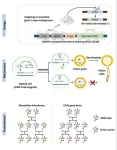(Press-News.org) Recent advancements show nanobodies from camelid antibodies excel in food allergen detection with superior stability, specificity, and cost-effectiveness. This innovative approach aims to improve accuracy and efficiency, crucial for preventing severe allergic reactions. The study highlights nanobodies' potential in reliable immunoassays, addressing rising food allergies and enhancing safety measures.
Food allergies pose significant health risks, affecting millions worldwide, with the prevalence rising over the past decades. Traditional detection methods, such as monoclonal and polyclonal antibodies, are often costly, labor-intensive, and prone to cross-reactions. The need for accurate, efficient, and cost-effective allergen detection methods is more pressing than ever. Due to these challenges, there is a growing interest in exploring new detection strategies. Based on these challenges, it is essential to conduct in-depth research to develop advanced detection techniques that can better safeguard public health.
Researchers from Tianjin Key Laboratory of Food Science and Health, Nankai University, China have made significant strides in this field. Their review (DOI: 10.1093/fqsafe/fyae018), published on March 28, 2024, in the journal Food Quality and Safety, introduces the use of nanobodies for food allergen surveillance, potentially revolutionizing the way we detect and manage food allergies.
The study highlights the advantages of nanobodies over traditional antibodies in food allergen detection. Derived from camelid heavy-chain antibodies, nanobodies are small, stable, and highly specific, making them ideal for robust immunoassays. They minimize cross-reactions and effectively detect allergens like macadamia, peanut, lupin, and milk proteins. A key highlight is their ability to target conformational epitopes, offering higher precision in allergen detection, especially in complex food matrices. The research also demonstrates the versatility and efficiency of nanobodies in various detection methods, such as Enzyme-Linked Immunosorbent Assay (ELISA) and electrochemical immunoassays, showcasing their broad applicability.
Prof. Dr. Shuo Wang, one of the leading researchers in this field and the leader of this research, stated, "The development of nanobody-based immunoassays marks a significant advancement in food allergen detection. Nanobodies offer unparalleled stability and specificity, addressing the critical need for more accurate and efficient methods to protect sensitive individuals from food allergens. This research paves the way for future innovations in food safety."
The research implications are significant. Nanobody-based detection methods could revolutionize food allergen surveillance, offering reliable, cost-effective solutions, enhancing food safety, and reducing allergic risks. Additionally, this study opens new avenues for developing therapeutic strategies and diagnostic tools, highlighting nanobodies' versatility in biomedical applications.
###
References
DOI
10.1093/fqsafe/fyae018
Original Source URL
https://doi.org/10.1093/fqsafe/fyae018
Funding information
This research was funded by the National Natural Science Foundation of China (No. 32272403) and the National Key Research and Development Program of China (No. 2022YFF1102400).
About Food Quality and Safety
Food Quality and Safety (FQS) is an open access, international, peer-reviewed journal providing a platform to highlight emerging and innovative science and technology in the agro-food field, publishing up-to-date research in the areas of food quality, food safety, food nutrition and human health. It is covered by SCI-E and the 2022 Impact Factor (IF)=5.6, 5-yr IF=6.2.
END
Camelid nanobodies: Transforming food allergen analysis
2024-06-17
ELSE PRESS RELEASES FROM THIS DATE:
Federal study examines care following nonfatal overdose among Medicare beneficiaries; identifies effective interventions and gaps in care
2024-06-17
Researchers from the Substance Abuse and Mental Health Services Administration (SAMHSA), the National Institutes of Health’s (NIH) National Institute on Drug Abuse (NIDA), Centers for Medicare & Medicaid Services (CMS), and the Centers for Disease Control and Prevention (CDC) found that among a cohort of 137,000 Medicare beneficiaries who experienced a nonfatal overdose in 2020, almost 24,000 (17.4%) experienced a subsequent nonfatal overdose, and about 1,300 (1%) died from overdose in the following year. Results were published today in JAMA Internal Medicine, identifying both effective interventions and significant gaps in care.
“People who have experienced ...
Maternal inheritance of Alzheimer’s disease tied to increased risk of developing disease
2024-06-17
KEY TAKEAWAYS
Mass General Brigham researchers analyzed 4,400 cognitively unimpaired adults with amyloid imaging, finding increased amyloid in those who reported that their mothers had symptoms of Alzheimer’s disease (AD).
Increased amyloid, a biomarker of AD, was also found in those with a history of the disease on both sides of their family and in those whose fathers had an early onset of symptoms.
The study suggests that a person’s maternal versus paternal family history could ...
Epidemiologic features of recovery from SARS-CoV-2 infection
2024-06-17
About The Study: More than 1 in 5 adults did not recover within 3 months of SARS-CoV-2 infection in this cohort study. Recovery within 3 months was less likely in women and those with preexisting cardiovascular disease and more likely in those with COVID-19 vaccination or infection during the Omicron variant wave.
Corresponding Author: To contact the corresponding author, Elizabeth C. Oelsner, M.D., M.P.H., email eco7@cumc.columbia.edu.
To access the embargoed study: Visit our For The Media website at this link https://media.jamanetwork.com/
(doi:10.1001/jamanetworkopen.2024.17440)
Editor’s Note: Please see the article for additional information, ...
Electronic cigarettes vs varenicline for smoking cessation in adults
2024-06-17
About The Study: This randomized clinical trial found that varenicline and nicotine-containing electronic cigarettes were both effective in helping individuals in quitting smoking conventional cigarettes for up to 6 months.
Corresponding Author: To contact the corresponding author, Anna Tuisku, Ph.D., email anna.tuisku@lapha.fi.
To access the embargoed study: Visit our For The Media website at this link https://media.jamanetwork.com/
(doi:10.1001/jamainternmed.2024.1822)
Editor’s Note: Please see the article ...
Risk factors for long COVID revealed
2024-06-17
NEW YORK, NY (June 14, 2024)--Early in the pandemic, many people who had SARS-Cov-2 infection or COVID-19 began to report that they couldn’t shake off their symptoms even after a month or more—unusually long for a viral infection of the upper respiratory tract—or developed new, persistent symptoms soon after the infection cleared.
Although it’s still not clear what causes post-COVID-19 conditions or “long COVID” (symptoms and conditions that develop, linger, or reoccur weeks or months after SARS-CoV-2 infection), a new study by researchers at Columbia University Vagelos College ...
Ancient polar sea reptile fossil is oldest ever found in Southern Hemisphere
2024-06-17
An international team of scientists has identified the oldest fossil of a sea-going reptile from the Southern Hemisphere – a nothosaur vertebra found on New Zealand’s South Island. 246 million years ago, at the beginning of the Age of Dinosaurs, New Zealand was located on the southern polar coast of a vast super-ocean called Panthalassa.
Reptiles first invaded the seas after a catastrophic mass extinction that devastated marine ecosystems and paved the way for the dawn of the Age of Dinosaurs almost 252 million years ago. Evidence for this evolutionary milestone has only been discovered in a few places around the world: on the Arctic island of Spitsbergen, northwestern North ...
Finding hidden genetic treasure: Study uncovers untapped diversity in historic wheat collection
2024-06-17
A decade-long collaborative study has discovered huge genetic potential that is untapped in modern wheat varieties.
The international study which appears in Nature reveals that at least 60% of the genetic diversity found in a historic collection of wheat is unused providing an unprecedented opportunity to improve modern wheat and sustainably feed a growing global population.
To make this discovery, a cross-institutional collaboration led by Dr Simon Griffiths, at the John Innes Centre and Professor Shifeng Cheng at the Agricultural Genomics Institute at Shenzhen, Chinese Academy of Agricultural Sciences (CAAS), studied the A.E. Watkins Landrace Collection, a ...
Researchers develop plant gene drive system for enhanced trait inheritance
2024-06-17
A collaborative research team led by QIAN Wenfeng from the Institute of Genetics and Developmental Biology (IGDB) of the Chinese Academy of Sciences and Peking University has developed a plant gene drive system called CRISPR-Assisted Inheritance utilizing NPG1 (CAIN), which, according to the researchers, uses a toxin-antidote mechanism in the male germline to override Mendelian inheritance in plants.
Their findings were published in Nature Plants.
In nature, gene inheritance typically follows Mendel's laws, which provide an equal chance for alleles to pass on to ...
Children’s Tumor Foundation presents the 2024 Global NF Conference in Brussels: Shaping what’s next for NF
2024-06-17
(NEW YORK, NY and BRUSSELS, BELGIUM) - June 17, 2024 - The 2024 Global NF Conference, organized by the Children’s Tumor Foundation (CTF) and the European NF Group, and hosted by Children's Tumor Foundation Europe, is the foremost assembly defining the scientific and medical future of the genetic conditions neurofibromatosis and schwannomatosis (known collectively as NF). This global gathering, taking place from June 20-25 at THE EGG in Brussels, Belgium, will connect over 1,000 attendees for up-to-date knowledge and insights in the growing fields of NF research ...
Researchers discover potential mole reversal therapy in rare condition
2024-06-17
Francis Crick Institute press
Peer reviewed
Experimental study
Cells, people and animals
*Case studies available for interview*
Researchers discover potential mole reversal therapy in rare condition
“Knowing there has been a huge step forward in the CMN research and there could be a chance of Ada’s CMN being reversed and possibly reducing Ada’s risk of developing melanoma, has blown our expectations out the water.” Ada’s Mum and Dad, Rachelle and Greg
Researchers at the Francis Crick Institute, UCL Great Ormond Street Institute for Child Health and Great Ormond Street ...





